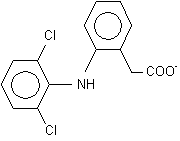Case JP, Baliumnas AJ, Block JA. Lack of efficacy of acetaminophen in treating symptomatic knee osteoarthritis. A randomized, double-blind, placebo-controlled comparison trial with diclofenac sodium. Arch Intern Med 2003; 163:169-178.
* PRACTICE RECOMMENDATIONS
Diclofenac 150 mg/d is more effective in controlling osteoarthritis symptoms than acetaminophen 4 g/d in patients previously requiring an nonsteroidal anti-inflammatory drug (NSAID).
Since acetaminophen is less expensive and better tolerated, it is reasonable to attempt a 2-week trial in all patients prior to initiating treatment with NSAIDs.
* BACKGROUND
A small number of studies have compared the effectiveness of acetaminophen with various NSAIDs, with some studies showing equivalence and others showing acetaminophen coming up short. These studies are the basis on which current clinical guidelines recommend acetaminophen over NSAIDs as initial therapy. This study evaluated the effectiveness of acetaminophen (Tylenol) and diclofenac sodium (Voltaren) compared with placebo in adults with osteoarthritis of the knee.
* POPULATION STUDIED
The 82 patients in this study were men and women aged 40 to 75 years, recruited from a rheumatology clinic, with unilaterally symptomatic osteoarthritis of the knee. Patients had radiographic evidence of osteoarthritis (Kellgren-Lawrence grade [greater than or equal to] 1) and medial compartment involvement.
Clinical criteria for entry were pre-enrollment ambulatory pain assessed by a visual analog score [greater than or equal to] 30 mm on a 100-mm scale; moderate pain, assessed with 5-point Likert scale; or increased pain, evidenced by an increase of [greater or equal to] 10 mm on visual analog scale or [greater then or equal to] 1 on Likert scale when taken off their previous analgesic during the initial 2 weeks of no treatment.
Furthermore, these patients had to be capable of independent ambulation without the use of a cane or walker and were within 1 standard deviation of weight for their height according to an actuarial life insurance table.
* STUDY DESIGN AND VALIDITY
This research was a randomized, double-blind, placebo-controlled study. Initial allocation to treatment groups was concealed. After a 2-week washout period, patients were randomized to receive treatment with diclofenac (75 mg twice daily), acetaminophen (1000 mg 4 times daily), or matching placebo for 12 weeks. Follow-up visits were scheduled at weeks 2 and 12, at which time pain and function were evaluated. Analysis of data was performed on an intention-to-treat basis.
This study was well done; however, some aspects deserve comment. This is a study of the comparative effectiveness of acetaminophen in a group of patients for whom acetaminophen already was shown not to work. All patients were recruited from a rheumatology clinic and had to have increased pain during the 2-week washout period, during which they were not allowed to take any of their previous pain medications.
Most of the patients (71%) were taking an NSAID alone or in combination with acetaminophen before the study started. Because acetaminophen has been advocated as first-line therapy for osteoarthritis for almost 10 years, these patients had very likely tried acetaminophen without success long before the study was started.
Also, there was a marked difference in tolerability between the 2 treatments. Of 82 patients, 21 withdrew prior to week 12. The patients that withdrew from the diclofenac group did so mainly due to adverse effects, whereas those that withdrew from the acetaminophen and placebo groups did so mostly due to ineffectiveness.
* OUTCOMES MEASURED
The primary outcome was efficacy as measured by the Western Ontario and McMaster Universities Osteoarthritis Index (WOMAC) at 2 and 12 weeks. This instrument assesses pain, stiffness, and function.
* RESULTS
Only patients treated with diclofenac experienced a significant improvement in the primary outcome--the WOMAC--at week 2 (27%; P=.001) and week 12 (25.6%; P=.001) compared with baseline. The individual components (pain, stiffness, and function) of the WOMAC each showed clinical and statistically significant improvement compared with baseline scores at 2 and 12 weeks in the diclofenac-treated group only.
Predictably, when those patients who had previously taken an NSAID were analyzed, there was a significant response in the diclofenac-treated group but not in the acetaminophen or placebo groups. The response from acetaminophen was similar to that seen with placebo and was not significantly different from baseline scores.
R. Marc Via, MD, Department of Family and Community Medicine, Scott & White Memorial Hospital, Texas A & M University System Health Science Center College of Medicine, Temple, Tex. E-mail: mvia@swmail.sw.org.
COPYRIGHT 2003 Dowden Health Media, Inc.
COPYRIGHT 2003 Gale Group



